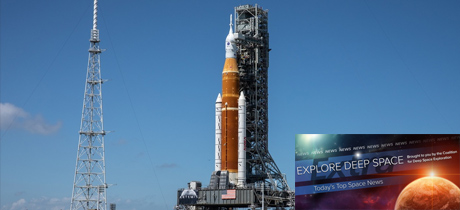In Today’s Deep Space Extra… Astronaut Mark Vande Hei returns to Earth with Russian colleagues after a U.S. record-setting 355 days in space. NASA looks to Friday to initiate the Artemis I Wet Dress Rehearsal. The New Horizons mission suggests Pluto is volcanic.
Human Space Exploration
NASA ready for high-stakes, low-profile SLS test
SpaceNews.com (3/29): NASA’s Artemis I Wet Dress Rehearsal (WDR), a countdown simulation of the Space Launch System (SLS) rocket and Orion crew capsule that will include cryogenic propellant loading, is set to begin on Friday about 5 p.m. EDT and conclude on Sunday. Propellant loading is scheduled for Sunday at 7 a.m. EDT. NASA will provide little coverage of the test itself. The agency said March 28 that it will provide a live video feed of the pad during the test, but without any commentary or sound, including audio from launch control. Agency representatives said the lack of audio from launch control was in response to export control concerns. With a successful outcome, the rehearsal could set the stage for Artemis I. Currently, June could likely offer the initial actual launch opportunity.
Live coverage: NASA astronaut returning home today with two Russian cosmonauts
Spaceflightnow.com (3/30): NASA astronaut Mark Vande Hei completed his journey back to Earth to conclude a U.S. record-setting 355 days in space, living and working aboard the International Space Station (ISS). Vande Hei was seated next to cosmonauts Anton Shkaplerov and Pyotr Dubrov as their Soyuz MS-16 undocked from the ISS at 3:21 a.m. EDT. The MS-19 executed a re-entry maneuver into the Earth’s atmosphere at 5:29 a.m. EDT, to set up a parachute-assisted descent into Kazakhstan with a touchdown at 7:28 a.m. EDT. His 355 days surpass the previous U.S. record of 340 days set by retired NASA astronaut Scott Kelly over 2015-16. The three astronauts will be flown by helicopter to Karaganda in Kazakhstan, where Vande Hei will board a NASA jet to be flown to Houston, Texas.
Space Science
This is where the Mars Sample Return mission could be landing
Universetoday.com (3/29): High resolution imagery from NASA’s Mars Reconnaissance Orbiter (MRO) hints at a possible landing site for the Mars Sample Return Mission that the agency is working with the European Space Agency (ESA) to develop. The goal of the mission is to gather samples of rock and soil cored and cached by NASA’s Mars Perseverance rover for return to Earth, a first. The MRO imagery hints at a landing site just to the west of Jezero Crater, where Perseverance landed in February 2021.
Pluto has a huge field of bumpy ice created by massive volcanoes
Newscientist.com (3/29): NASA’s New Horizon mission, launched in 2006, conducted the first ever close flyby of Pluto in July 2015. Researchers from the Southwest Research Institute believe the imagery reveals volcanoes that ejected ice from the planet’s interior and onto large regions of the surface. They may still be active. “There’s not really anything anywhere else in the solar system that looks like this,” according to researcher Kelsi Singer. Findings were published in the journal Nature Communications.
Sun erupts with 17 flares from single sunspot, sending solar storms toward Earth
Space.com (3/29): An overactive sunspot, AR2975, has erupted at least 17 times in recent days, sending flares towards the Earth, which could produce some colorful aurorae. Imagery of the activity was captured by NASA’s Solar Dynamics Observatory and the Solar and Heliospheric Observatory. The first of the Coronal Mass Ejections (CME) is expected to reach the Earth on Thursday with at least one more on Friday. Currently, the sun is in the early phase of its 11-year solar cycle, which started in December 2019.
Other News
Biden Administration embraces Office of Space Commerce in FY2023 budget
Spacepolicyonline.com (3/29): The proposed 2023 fiscal year budget presented to Congress by President Biden on Monday includes support to transition responsibility for civil satellite Space Situational Awareness from the Department of Defense (DoD) to NOAA’s Office of Space Commerce (OSC). The White House 2023 budget request would increase OSC’s funding to $87.7 million, a sharp increase from the $16 million appropriated over 2022. An additional $2 million is proposed for the Department’s Bureau of Economic Analysis to create a new “Space Economy Satellite Account” to measure the contribution of space-related industries to economic growth.
China debuts Chang Zheng 6A, teases more variants
NASAspaceflight.com (3/29): Launch of China’s two-stage Chang Zheng 6A rocket debuted Tuesday with two payloads headed for sun-synchronous orbit from the new launch pad at the Taiyuan Satellite Launch Center. The core stage is powered by two YF-100 engines which used RP-1 kerosene and liquid oxygen (LOX) as propellants and four solid rocket boosters.

